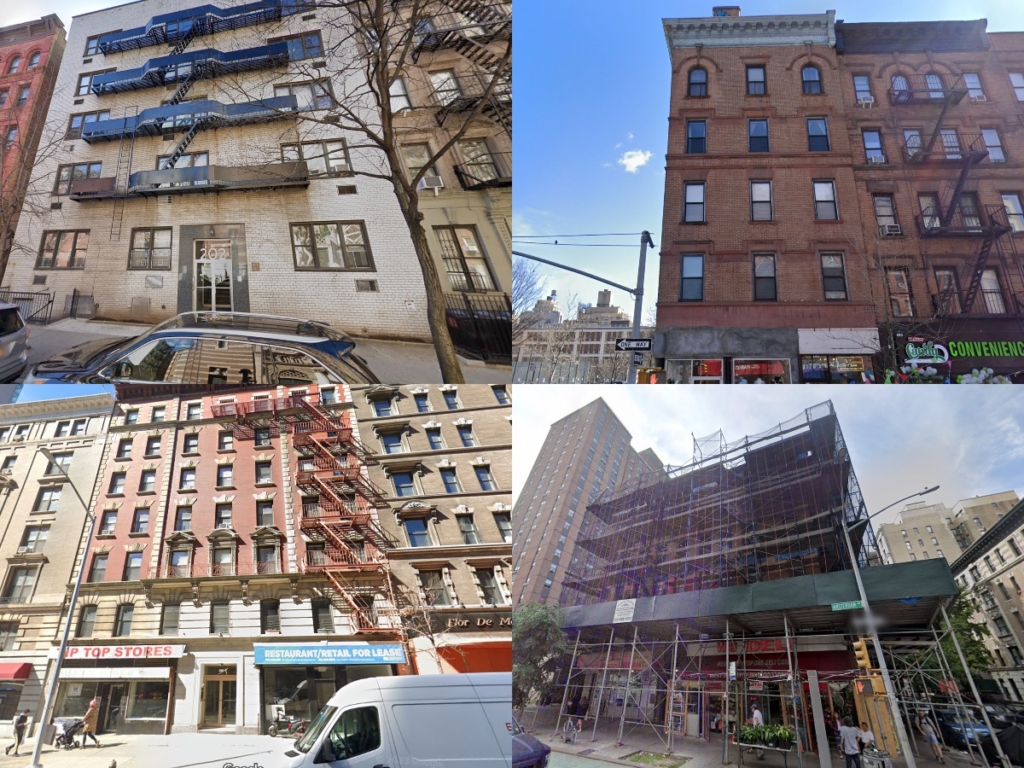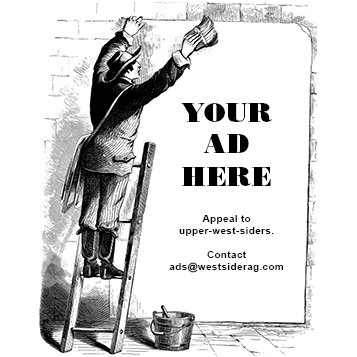
By Gus Saltonstall
The annual list of the “worst landlords” in New York City was released this week by the Public Advocate’s Office, and a collection of Upper West Side buildings appeared in the ranking.
In total, six of city’s worst landlords own seven buildings on the Upper West Side, including the overall worst-ranked landlord in the five boroughs.
The annual list aims to “spotlight and shame the most egregiously negligent property owners in the city,” and is determined by the number of housing violations in a given building from December 2022 to November 2023. Those violations can include things such as heat and hot water outages, rodent infestations, and deteriorating infrastructure.
Here are the Upper West Side buildings that are owned by the landlords named among the worst 100 in the city.
250 West 72nd Street (between West End and Broadway)
- Landlord: David Deutsch
- Organization: 250 West 72nd Street LLC
- Number of HPD violations: 59
202 West 82nd Street (between Broadway and Amsterdam)
- Landlord: Magdalena Kosz
- Organization: 202 West 82nd Street LLC
- Number of HPD violations: 126
104 West 83rd Street (between Amsterdam and Columbus)
- Landlord: Johnathan Santana
- Organization: Sonora Associates, LLC
- Number of HPD violations: 119
495 Amsterdam Avenue (off the corner of Amsterdam)
- Landlord: David Gomez
- Organization: 495 Amsterdam LLC
- Number of HPD violations: 39
698 Amsterdam Avenue (near West 94th Street)
- Landlord: Ivan Disla
- Organization: Ninety Fourth Street LLC
- Number of HPD violations: 127
700 Amsterdam Avenue (near West 94th Street)
- Landlord: Ivan Disla
- Organization: Ninety Fourth Street LLC
- Number of HPD violations: 177
2647 Broadway (between West 100th and 101st streets)
- Landlord: Jonah Bamberger
- Organization: 2647 Broadway Apts LLC
- Number of HPD violations: 125
Johnathan Santana, who is part of the ownership team at 104 West 83rd Street, was named the “worst landlord” in the city for the second year in a row.
Santana is the designated head officer for Daniel Ohebshalom, who had previously amassed the most open violations in the list’s history last year. Santana, however, surpassed Ohebshalom this year by accumulating 3,293 open violations across 306 units in buildings for this year’s list.
“Johnathan Santana and Daniel Ohebshalom may be shameless in their negligence and predatory practices, as is clear in their record violations, but it’s clear that spotlighting and shaming them and other worst landlords in the city can have meaningful impact,” Public Advocate Jumaane Williams said in a news release.
Santana’s building on West 83rd Street wasn’t the property with the most violations featured on this year’s list, though; that dubious honor went to the 177 violations at Disla’s 700 Amsterdam Avenue.
That building on the corner of West 94th Street currently has a “stop work order” because of “civil penalties due,” according to the Department of Buildings. The property is currently blanketed with scaffolding and its most recent violations include failure to file inspections, failure to certify correction on something “immediately hazardous,” and more, according to the DOB’s website.
You can check out the most recent list of the “Top 100 Worst Landlords Watchlist” for yourself — HERE.
Subscribe to WSR’s free email newsletter here.









I guarantee that the apartments in each of these buildings are predominantly rent controlled or rent stabilized.
When the landlord’s income is restricted he either does not have the cash flow to properly maintain the building or he simply lacks the economic incentive to properly maintain the building.
This is predicted by basic economics theory and this is why there are so many rundown and decaying buildings in the city. Market rate apartment buildings almost never have these multiple violations because the landlord is incentivized to provide proper maintenance.
This is one more example of progressive policies causing more harm than good.
Rubbish. If they weren’t making money they wouldn’t have a portfolio, of buildings. Slum lords all
WRONG. In the 60’s-70’s real estate taxes and operating costs were a fraction of what they are today and buildings were operated profitably. Then things turned and landlords were screwed. They can’t sell these properties out of their portfolios now. Would you buy one of those buildings for $1 if you knew that it would cost you more to operate than it generated in rental income ?
Otis –
There are very few Rent-Controlled apartments left.
RC ended years ago and any remaining tenants would be very old. Also landlords can actually get RC rent increases if there are “capital improvements”
Rent Stabilization is a different entity with different rules
What bull. they’re making millions off these apartments and have massive portfolios. All these landlords own dozens of buildings.
If market rate buildings and deregulation worked we wouldn’t be at record high homeless populations nationwide.
I know WSR is on the conservative Reddit boards as a comments section to flood but please spare us the Manhattan Institute disinformation
I looked it up for you and did a good half hour of research. Half of these buildings are rent stabilized with extremely high turnover, and not incredibly low rents for what they are (the lowest I found was $1600 for a 300sq ft studio)
The others – notably, the one owned by the second worst landlord in all of NYC – are all market rate.
Sounds like some of these guys are *maybe* cash restricted. The others are just jerks.
Most of the rent stabilized apartments on the UWS that are vacant are typically given to friends and families of landlords or brokers they work with, if not that then they typically want specific kinds of people who won’t stay long in an apartment such as expats or students.
This is largely true if rent regulated unit in question is below market rate. It has become even more so after 2019 changes in laws that removed vacancy increases.
Also RS units cannot be renovated and then removed from system under “luxury decontrol” either.
RS system in New York rewards long term tenants. Boomers and what’s left of their parents generation are aging and dying off. Many of those apartments have low to very regulated rents. Suffice to say they are not being put onto market.
While yes such units may be given to insiders, but also a LL may not rent them at all because regardless who takes the apartment once they’re in it’s impossible to get them out.
Curiously, these landlords don’t abandon their buildings, as Otis’s economic theorizing would predict. They find it profitable to keep collecting the rents.
Few to nil multi-family (rental) does not have debt to service.
Owners who “abandon” a property would still be liable for debts, taxes and so forth until creditor and or other lien holders (such as for unpaid taxes) steps in and forecloses or otherwise seizes property.
Situation is no different than an owner of a single family home who is “house poor”.
Income only allows them to keep utilities on, pay taxes and so forth. OTOH there is no money for major improvements or maintenance so property slowly goes to rot and ruin.
Landlords are still making money by severely cutting back on proper maintenance.
What’s your point?
You really think the solution is to get rid of rent-stabilized apartments in a city severely lacking affordable housing?
Rent regulated housings is only “affordable” when household income is greater in large part than monthly income. For good number of RS tenants that simply is not true. This points to another failing of RS system.
RS tenants are only vetted for income once, when applying for unit. Afterwards if household income does not keep up with or surpass increases in rent problems start.
Half or more of RS tenants are “rent burdened”, paying 30% to 50% or more of monthly income towards housing. They don’t have any choice, even with a “cheap” below market rent of say $1400/month for a studio apartment in Manhattan, if monthly income is only $1200 or less, such tenants won’t find another such unit cheaper, so it’s either pay rent or become homeless.
Good number of middle aged, senior citizens and elderly you see going through trash bags or bins in front of stores or supermarkets are not homeless. Rather they are rent regulated tenants who simply are financially stretched.
Not paying rent will get such persons evicted. Thus they pay good portion of income each month towards rent and survive on what’s left best they can.
So much for “affordable” housing.
This is the exact solution, thank you.
Well there are precedents.
When Boston finally ended rent regulation quality and supply of multi-family housing increased. Rents however rose most for units that weren’t previously subjected to regulation.
https://reason.com/2023/02/15/massachusetts-voters-ended-rent-control-decades-ago-bostons-mayor-wants-to-bring-it-back/
https://www.thecrimson.com/article/2023/12/13/rent-control-cambridge-feature/
It’s just a natural fact of economics that when government places restrictions upon prices owners of said commodities will find other ways to make their money.
New York has had rent regulation for > 60 years. Still somehow, somehow same people are always moaning about lack of “affordable housing”. Clearly rent regulation just isn’t working out.
Using rent regulation to provide “affordable” apartments is a bit like trying to put out a fire by pouring gasoline on it.
Get rid of rent regulation and there will be plenty of affordable housing for everyone- not just an entitled few.
Um … just how would that work? Letting all rental rates rise to whatever the market will bear will lead to affordable housing? Market rates at present put housing out of reach for so many.
Both rent control and stabilization actually benefit a small number of NYC residents.
RC or RS tenants in Manhattan often are only ones paying below market rates. OTOH legal rent regulated rents in Bronx, Queens and Brooklyn are often higher than market rates.
Income for rent regulated tenants in core of Manhattan are highest of all such tenants in city.
“Differences in gross rents are also much more pronounced in Manhattan than in the four other boroughs.
Table E shows that stabilized units rented in 2011 for about $1,235 per month lower than market-rate units in core Manhattan, but only $228 lower than market-rate units in Upper
Manhattan and the outer boroughs. ”
https://furmancenter.org/files/FurmanCenter_FactBrief_RentStabilization_June2014.pdf
Carol, no one is suggesting that. But we could link rent stabilization to income or occupation. Right now, many wealthy people with country homes have rent controlled or rent stabilized apartments in NYC. That is not right.
Lisa, wealthy stabilized tenants are rare. Here’s HPD’s report from 2017 (lots more interesting data to check out here, too): “The median income of rent stabilized households is $44,560 compared to $67,000 for households in private, non-regulated units. Although rent stabilized units are not means-tested, the households that occupy them are more likely to have incomes that place them below 30% of HUD Income Limits (the income range that is typically served by public housing, housing choice vouchers, and deeply subsidized
affordable housing programs) and below 80% of HUD Income Limits (the income range targeted by LIHTC and many other affordable housing programs) than households in non-regulated units.” https://www.nyc.gov/assets/hpd/downloads/pdfs/services/rent-regulation-memo-1.pdf
This report is wildly misleading as it includes the entire city. There are instances in poor parts of the city where the amount the landlord is allowed to charge for a RS unit is actually higher than what the market dictates. In other words, the maximum rent that someone is willing to pay is much less than the RS limit. So RS is useless in these areas.
A more accurate and useful study would be to review the socioeconomic status of people living in RS apartments in wealthier areas, use the UWS and UES. I guarantee the study will show wealthy people living in these units. Even the study you referenced notes that RS laws are not needs based.
I know two renters who can definitely afford to pay higher rents than the rent-controlled rents they now pay. They both earn well over 100K and one of them has a ‘second’ home in Westchester. The rent control system is a disgrace if that can occur.
I wish there was a means that the city could throw these landlords in jail. Doing so might makes these greedy landlords think twice about neglecting their properties and putting their tenants lives at risk.
NYC seizing the property would be better
And giving it to the right developers? We have a real estate lobbyist running for office on the UWS Melissa Rosenberg.
No it wouldn’t. NYCHA is by far the worst property manager in the city. And if you mean eminent domain the city would have to purchase the properties.
Why aren’t these landlords fined? Imprisoned?
Fined sure. Imprisoned? No. I thought we were ending mass incarceration, downsizing the NYPD etc.
Greed should be punished and their resources distributed back into the community.
Because we don’t imprison people for civil crimes. You have to be charged with and convicted on a criminal crime to go to prison.
Actually persons can be held in contempt of court for not obeying civil court orders.
Judges in past have thrown LL’s into jail (or threatened same) for failing to comply with court orders say in regard to making repairs.
https://gothamist.com/news/in-rare-occurrence-brooklyn-landlord-spends-time-in-jail-over-apartment-violations
https://www.syracuse.com/news/2023/07/judge-orders-notorious-syracuse-landlord-troy-green-to-pay-152k-or-face-30-days-in-jail.html
https://www.thecity.nyc/2022/09/27/flatbush-landlord-evener-leon-sentenced-tenant-jean-yves-lalanne-died-jumping-fire/
https://www.nydailynews.com/2013/10/09/judge-orders-filthy-bronx-landlord-to-jail/
These people want dangerous criminals out on the street but private property owners to be imprisoned.
Good list to highlight! Would WSR be able to report further- in one building, some interviews with residents, with any building maintenance people, and with any landlords reps who will talk? It would be good to know some of the underlying issues. Are they waiting for residents to leave so they can renovate/sell/raise rents? Do landlords claim deadbeat tenants? Are there rent strikes/ maintenance issues? What are the most hazardous outstanding violations? Worst violations according to tenants? Are there paths for redress for anyone ? Any hopeful stories? (Or is this all reported elsewhere anyone is aware of?)
I want to know about that half block of empty/warehoused apartments in the high 80s on Amsterdam where Mermaid Tavern used to be. That building is being run into the ground so it can be redeveloped. Maybe 50-60 apartments in both buildings total
It was announced this past summer much of that block is coming down for redevelopment.
From Crain’s NY
“A new project is likely on its way at the former home of The Mermaid Inn on the Upper West Side.
Developer Frank Ortiz of Amsterdam 88 LLC recently filed demolition permits with the Department of Buildings for 568, 570, 572 and 574 Amsterdam Ave., all located between West 87th and 88th streets. The four properties stand between 5 and 6 stories and 60 and 62 feet tall, and they span 46,000 square feet in total. The estimated job cost is $1.2 million, or $300,000 for each building, according to the filing.”
https://www.crainsnewyork.com/real-estate/demolition-permits-filed-former-site-upper-west-side-seafood-restaurant-mermaid-inn#:~:text=A%20new%20project%20is%20likely,West%2087th%20and%2088th%20streets.
Or, https://ilovetheupperwestside.com/.well-known/captcha/?r=%2Fold-mermaid-inn-building-to-be-demolished-report%2F
That is so depressing and awful for the neighborhood
Cannot see how new modern housing replacing tired and worn old tenement is “depressing” or “awful” for neighborhood.
Good reporting. However, it is obvious from the number of violations and the fact that the same malefactors appear after year that the penalty system is toothless (like the penalties for driving with a suspended or revoked license). Also, I wonder whether violations are overlooked at NYCHA buildings.
As it pertains to NYCHA, see below
https://www.thecity.nyc/2023/08/25/hpd-disclosure-nycha-code-violations/
Is there a report on unrepaired violations in NYCHA buildings? Who inspects vs who repairs?
It appears NYCHA does not follow reporting laws, which may extend further into not making violations public. There are many articles related to NYCHA not responding to items such as lead, water quality, heat. One could look at all the complaints made through 311 for a particular address that would not get you the violations or correction information though.
“Johnathan Santana, who is part of the ownership team at 104 West 83rd Street, was named the “worst landlord” in the city for the second year in a row. Santana is the designated head officer for Daniel Ohebshalom, who had previously amassed the most open violations in the list’s history last year. Santana, however, surpassed Ohebshalom this year by accumulating 3,293 open violations across 306 units in buildings for this year’s list.”
The question is: knowing this, why is it allowed to continue? What is the problem here with enforcement? Why are these men not in jail? What the hell is going on?
According to the internet there are no rent stabilized units in 202 West 83 rd Street.. it is described as one of the most risky buildings for renters.
No one should be allowed to have the number of violations that these buildings have without the landlord having to pay severe consequences.
What is unfortunate is that 342 W 71ST is not included on the list, despite over 400 Complaints to 3-1-1 and over 130 open violations. The landlord is listed as #88, on the worst landlord list.
Surprised Bosco and Stellar Mgmt aren’t on the list…
Brusco is well respected on the Upper West Side. Joe Brusco is on the Columbus Avenue Bid and is good friends with Barbara Adler, a CB7 member.
Our landlord was on that list last year but he has his building showing up under a bogus name using his office address . All his buildings show up under this phantom super we all are suppose to have peter tran . Tried to give the city a heads up but they have not corrected anything .
250 West 72nd seems to have no issues finding tenants.
https://streeteasy.com/building/250-west-72-street-new_york/1a
https://streeteasy.com/building/250-west-72-street-new_york/3c
Streeteasy and other sources state building went up in 1957, but that isn’t true. 250-254 what’s left of a series of rowhouses that went up in 1887. This was about four years after the Dakota Apartments on CPW and 72nd went up. As years went by West 72nd began to fill in with rowhouses built for middle and slightly above classes.
https://daytoninmanhattan.blogspot.com/2015/04/gothic-surprises-nos-250-254-west-72nd.html
For those interested city has created a one stop shopping source if you will to research buildings.
New HPD website allows one to look up any property in NYC and see complaints, violations and etc… of all types and sources and how they were disposed.
https://hpdonline.nyc.gov/hpdonline/building/35012/complaints
Using 250 West 72nd as an example building has over thirty complaints.
Vermin (mice, flies), heat/hot water, peeling paint, mold….
What is interesting and you see this time and time again for all buildings in NYC large numbers of complaints are simply listed as “closed” by HPD. When you examine reasons for said action it’s usually along lines of “HPD examined …. and could not find evidence of…”
This happens a lot with vermin (if HPD or whoever responds to complaints does not see rats, mice, flies… or what they consider clear evidence of such, complaint is closed.
Same goes for heat and hot water. If inspector arrives and lo and behold one or both are within the law, again complaint is closed.
For these and some other reasons it is possible for a building to have dozens or scores of complaints purely based upon numbers reported. If fifty tenants make fifty complaints about same issue all are listed resulting in “50” complaints.
Many of issues listed for 250 West 72nd can be put down to one thing, the building is old (well over one hundred) and hasn’t seen proper maintenance. This likely did not begin with current owner but has been building for decades.
Kindest thing to do in these situations is either a total gut renovation of building or simply tearing it down and start new.
Exhibit A for everything that is wrong with NY rent regulation.
https://www.nytimes.com/2023/08/28/realestate/renters-upper-west-side.html
https://www.theguardian.com/lifeandstyle/2022/feb/10/new-york-apartments-photos-rent
I don’t understand why the ranking is by total number of violations and not by violations per unit. If I have 100 violations on 1 unit I am supposedly much worse than one who has 200 on 200 units.
Or there’s something I don’t understand about the nature of these violations.
From the press release itself: “the perpetual mismanagement of NYCHA makes the city itself the worst overall landlord for hundreds of thousands of New Yorkers. ”
So much for repossess those buildings and turn them into public housing…
Get rid of rent control and rent stabilized apartments, then values will normalize.
Send rich people back to the suburbs like the 1980’s, let the real New Yorkers have the city back.
Why would you think people want to go back to the suburbs? It’s miserable there.
Isn’t 104 West 83rd Street now a homeless shelter? Is the city providing the bad landlord income to house people? Seems like a messed up incentive…
Happens all the time…
https://www.thecity.nyc/2023/08/03/tax-break-bistricer-flatbush-gardens-violations/#:~:text=NYC%20Awards%20%24191%20Million%20Tax,at%20Brooklyn%27s%20beleaguered%20Flatbush%20Gardens.
Tenants in Jonathan Santana’s UES buildings often are no better off than UWS.
https://eastsidefeed.com/real-estate/worst-landlord-watchlist-ues-2023/